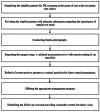Improving diabetic retinopathy screening at the point of care: integrating telemedicine to overcome current challenges
- PMID: 38877501
- PMCID: PMC11177507
- DOI: 10.1186/s12886-024-03508-4
Improving diabetic retinopathy screening at the point of care: integrating telemedicine to overcome current challenges
Abstract
Objective: To investigate the utility of point of care screening of diabetic retinopathy (DR) and the impact of a telemedicine program to overcome current challenges.
Methods: This was a retrospective study on people with type 2 diabetes mellitus (T2DM) who were screened for DR using the single-field non-mydriatic fundus photography at the point of care during routine follow-up visits at endocrinology clinic. Retinal images were uploaded and sent to a retina specialist for review. Reports indicating retinopathy status and the need for direct retinal examination were transmitted back to the endocrinology clinic. All patients were informed about DR status and, if needed, referred to the retina specialist for direct retinal examination.
Results: Of the 1159 individuals screened for DR, 417 persons (35.98%) were screen-positive and referred to the retina specialist for direct retinal examination. A total of 121 individuals (29.01%) underwent direct retinal examination by the specialist. Diabetes macular edema (DME) was detected in 12.1%. In addition, non-proliferative diabetic retinopathy (NPDR) and proliferative diabetic retinopathy (PDR) were detected in 53.4% and 2.6% of the patients, respectively.
Conclusion: Integrating DR screening program at the point of care at the secondary care services improves the rate of DR screening as well as detection of sight threatening retinopathy and provides the opportunity for timely intervention in order to prevent advanced retinopathy in people with T2DM.
Keywords: Adherence rate; Diabetes retinopathy; Fundus photography; Screening rate.
© 2024. The Author(s).
Conflict of interest statement
The authors declare no competing interests.
Figures
Similar articles
-
Prevalence of diabetic retinopathy in individuals with type 2 diabetes who had recorded diabetic retinopathy from retinal photographs in Catalonia (Spain).Br J Ophthalmol. 2015 Dec;99(12):1628-33. doi: 10.1136/bjophthalmol-2015-306683. Epub 2015 Jun 18. Br J Ophthalmol. 2015. PMID: 26089211 Free PMC article.
-
Evaluation of a combination digital retinal camera with spectral-domain optical coherence tomography (SD-OCT) that might be used for the screening of diabetic retinopathy with telemedicine: A pilot study.J Diabetes Complications. 2018 Nov;32(11):1046-1050. doi: 10.1016/j.jdiacomp.2018.08.010. Epub 2018 Aug 11. J Diabetes Complications. 2018. PMID: 30121204
-
Prevalence of diabetic retinopathy and diabetic macular edema in a primary care-based teleophthalmology program for American Indians and Alaskan Natives.PLoS One. 2018 Jun 20;13(6):e0198551. doi: 10.1371/journal.pone.0198551. eCollection 2018. PLoS One. 2018. PMID: 29924846 Free PMC article.
-
Prognostic factors for the development and progression of proliferative diabetic retinopathy in people with diabetic retinopathy.Cochrane Database Syst Rev. 2023 Feb 22;2(2):CD013775. doi: 10.1002/14651858.CD013775.pub2. Cochrane Database Syst Rev. 2023. PMID: 36815723 Free PMC article. Review.
-
Review of retinal cameras for global coverage of diabetic retinopathy screening.Eye (Lond). 2021 Jan;35(1):162-172. doi: 10.1038/s41433-020-01262-7. Epub 2020 Nov 9. Eye (Lond). 2021. PMID: 33168977 Free PMC article. Review.
Cited by
-
A Systematic Review of Telehealth Applications in Endocrinology.Telemed Rep. 2024 Sep 27;5(1):269-289. doi: 10.1089/tmr.2024.0032. eCollection 2024. Telemed Rep. 2024. PMID: 39463462 Free PMC article. Review.
References
-
- World Health Organization. Diabetic retinopathy screening: a short guide: increase effectiveness, maximize benefits and minimize harm. 2020.
MeSH terms
LinkOut - more resources
Full Text Sources
Medical



